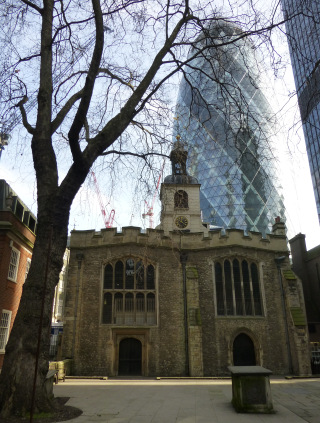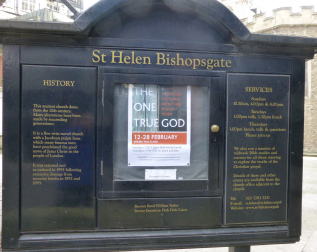 Very few churches survived both the Great Fire in 1666 and the Blitz during WW II - but St. Helen’s Bishopsgate did. Of the churches that have survived from before the Great Fire this is the largest and its architecture is unique - essentially two conjoined parallel churches -due to its unusual history. It was also William Shakespeare’s parish church when he first came to London and it purportedly has the largest collection of monuments in Greater London with the exception of Westminster Abbey. But one of the reasons I particularly like this church is its juxtaposition with the modernity around it. The view over the church to 30 St. Mary Axe is arguably one of the great images within London today.
Very few churches survived both the Great Fire in 1666 and the Blitz during WW II - but St. Helen’s Bishopsgate did. Of the churches that have survived from before the Great Fire this is the largest and its architecture is unique - essentially two conjoined parallel churches -due to its unusual history. It was also William Shakespeare’s parish church when he first came to London and it purportedly has the largest collection of monuments in Greater London with the exception of Westminster Abbey. But one of the reasons I particularly like this church is its juxtaposition with the modernity around it. The view over the church to 30 St. Mary Axe is arguably one of the great images within London today.
 History: While the very early history of the church is lost, it is dedicated to St. Helen which gives reasonable grounds to believe it was initially erected by Constantine (the first Roman Emperor who professed Christianity) in honour of his mother, Helena. There is also a record that King Edmund the Martyr, who died in 869, had his remains held here for three years. Records also document the church’s existence during the time of Henry II. By 1181 the church and land had been granted to the Dean and Canons of St. Paul’s. In 1210, the leaders of St Paul’s granted permission for a nunnery to be built in the grounds of the Priory church, now known as St Helen of the Benedictine Order. This new church is built directly along the north side of the existing church, but is both wider and longer. Consequently the existing parish church is lengthened to match its size. It is for this reason that St. Helen’s Bishopsgate appears to look like two conjoined churches, both from the outside and inside. In 1538 the Nunnery is handed over to Henry VIII’s control as part of his dissolution of priories. In 1543 the land and convent to the north of the church is sold to the Leathersellers’ Company. To further the elimination of the Nunnery, the wall separating the two conjoined churches is removed leaving the now single church to appear as it does today. From this period the church still contains a 1615 Jacobean pulpit, several brasses dating from 1465.
History: While the very early history of the church is lost, it is dedicated to St. Helen which gives reasonable grounds to believe it was initially erected by Constantine (the first Roman Emperor who professed Christianity) in honour of his mother, Helena. There is also a record that King Edmund the Martyr, who died in 869, had his remains held here for three years. Records also document the church’s existence during the time of Henry II. By 1181 the church and land had been granted to the Dean and Canons of St. Paul’s. In 1210, the leaders of St Paul’s granted permission for a nunnery to be built in the grounds of the Priory church, now known as St Helen of the Benedictine Order. This new church is built directly along the north side of the existing church, but is both wider and longer. Consequently the existing parish church is lengthened to match its size. It is for this reason that St. Helen’s Bishopsgate appears to look like two conjoined churches, both from the outside and inside. In 1538 the Nunnery is handed over to Henry VIII’s control as part of his dissolution of priories. In 1543 the land and convent to the north of the church is sold to the Leathersellers’ Company. To further the elimination of the Nunnery, the wall separating the two conjoined churches is removed leaving the now single church to appear as it does today. From this period the church still contains a 1615 Jacobean pulpit, several brasses dating from 1465.
 The church survived the Great Fire of 1666 making it one of the few churches in the city to do so. It also avoided destruction during WWII but was damaged in 1992 and 1993 by IRA bombs that were detonated nearby. Restoration of the damaged parts of the church was completed continuing this churches great history and making it the largest surviving church in the City from before the Great Fire.
The church survived the Great Fire of 1666 making it one of the few churches in the city to do so. It also avoided destruction during WWII but was damaged in 1992 and 1993 by IRA bombs that were detonated nearby. Restoration of the damaged parts of the church was completed continuing this churches great history and making it the largest surviving church in the City from before the Great Fire.
Shakespeare’s connection: William Shakespeare was known to have lived in the Parish of St. Helen’s Bishopsgate according to tax rolls from 1597. Interestingly it was his failure to pay taxes that caused this record to be made! The documentation implies that Shakespeare did attend and worship at this church. It was his first home in the City and would have been a convenient place for those travelling to the theatres in Shoreditch.
The Church Today: Services on Sundays are at 10:30am, 4pm and 6pm. Services on Tuesdays and Thursdays are from 1:00-1:40pm. Visitors have access to St Helen’s in the mornings (the church building is generally open to visitors Monday to Friday from 9.30am to 12.30pm) and entry is via the church office. If guests wish to visit at any other time the Church advises telephoning in advance to check availability.
Located at: (at the foot of the Gerkhin) Great St Helen’s, London, EC3A 6A
Closest Tube: Bank or Liverpool St

Nice post!
Thanks for the comment and the like. I appreciate it.
Will have to check it out. Love the photo of the church and the Gherkin ~
Thanks for the comment on the photo - its hard to get a full perspective of the Gherkin, and this is a great way to do it.
I was guiding this church this afternoon - the Westminster Abbey of the City!
Christine said:
I think I’m putting this on my “Places to Visit” list-which is getting rather long, by the way. I hope I have enough time for everything.
I use to work around the city and never noticed it, just goes to show what a work day in London is like, people need to stop and look around, then chill out.
I think this is the case in life, in general, everywhere. Great observation and something we all forget to do often enough.
Very interesting post. Thank You.
vickypaida said:
Never been there!!now I’m tempted and I want to go!nice post
Thanks for your comment - always good to know people read and enjoy these posts!
jsmf said:
the church services for this church are at 10.30 am, 4.00 pm and 6.00 pm.